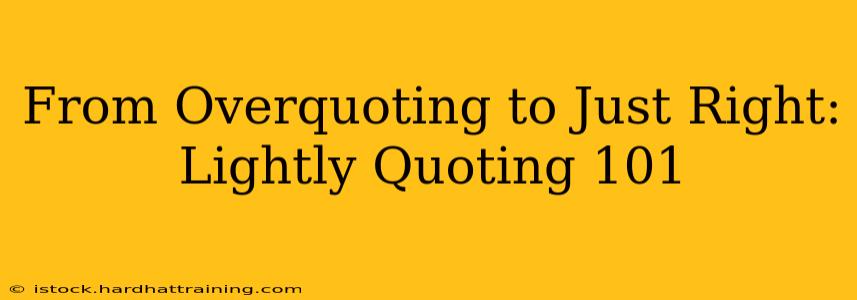Overusing quotes can make your writing seem clunky and unoriginal. This guide will show you how to use quotes effectively, focusing on the art of light quoting – integrating quotations seamlessly into your own writing style to enhance, not dominate, your work. We'll explore techniques that ensure your quotes support your argument without overwhelming your readers.
Why Light Quoting is Better Than Overquoting?
Overquoting often stems from a fear of misrepresenting the original source. However, excessive quoting can lead to several problems:
- Disrupts Flow: A string of long quotes interrupts the natural rhythm of your writing, making it difficult for the reader to follow your train of thought.
- Weakens Your Voice: Reliance on quotes diminishes your own unique perspective and analysis. Your voice gets lost in a sea of other people's words.
- Borrows Authority Unnecessarily: While quotes lend credibility, excessive use suggests a lack of confidence in your own ability to explain the ideas.
- Breaks Copyright Laws (potentially): Using extensive excerpts without proper attribution or falling under fair use guidelines can lead to legal issues.
Light quoting, on the other hand, allows you to integrate source material smoothly, highlighting key phrases or sentences that effectively support your arguments. This keeps your readers engaged and showcases your critical thinking skills.
How to Achieve the Right Balance: Techniques for Light Quoting
Here are some key strategies for incorporating quotes sparingly and effectively:
1. Summarize and Paraphrase:
Before resorting to a direct quote, consider summarizing or paraphrasing the source material in your own words. This demonstrates your understanding and strengthens your original contribution. Only quote when a specific word choice or phrasing is crucial to your analysis.
2. Use Short, Punchy Quotes:
Instead of lengthy quotations, select only the most relevant and impactful phrases or sentences. This keeps your writing concise and focused.
3. Integrate Quotes Smoothly:
Don't just drop quotes into your text. Introduce them smoothly with context and transition phrases like:
- "As [Author's Name] writes,..."
- "[Author's Name] argues that..."
- "According to [Source],..."
Make sure the quote flows naturally within your sentences.
4. Use Ellipses and Brackets Judiciously:
Ellipses (...) indicate omitted words within a quote. Use brackets [ ] to add clarifying words or to change capitalization without altering the original meaning. Be sparing with these modifications to maintain the integrity of the original source.
Frequently Asked Questions (FAQ)
How long should a quote be?
Aim for shorter quotes. Ideally, a quote shouldn't exceed one or two sentences. Longer quotes should be used exceptionally sparingly.
What if I need to quote a longer passage?
If absolutely necessary, consider breaking up a longer quote with your own analysis and commentary, or replacing parts of it with a paraphrase.
How many quotes should I use in a paper/article?
There's no magic number. The ideal number depends on the length and purpose of your writing. Focus on quality over quantity. Each quote should serve a specific purpose in supporting your arguments.
What are some alternatives to direct quotes?
Summarizing, paraphrasing, and using indirect quotations (e.g., "The author suggests that...") are excellent alternatives to direct quotes and often enhance clarity and flow.
Is it okay to quote myself in a different work?
Yes, provided proper attribution is given. This is called self-plagiarism when it isn't correctly cited. Different publications usually require slightly different citations – always follow their guidelines.
By mastering light quoting, you can transform your writing from a patchwork of borrowed voices into a compelling and original piece that showcases your critical thinking skills and insightful analysis. Remember, your voice is essential—let it shine!
